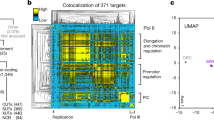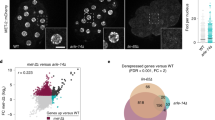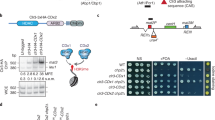Abstract
The establishment of silencing in Saccharomyces cerevisiae is similar to heterochromatin formation in multicellular eukaryotes. Previous batch culture studies determined that the de novo establishment of silencing initiates during S phase and continues for up to five cell divisions for completion. To track silencing phenotypically, we developed an assay that introduces Sir3 protein into individual sir3Δ mutant cells synchronously and then detects the onset of silencing with single-cell resolution. Silencing was completed within the first one to two cell divisions in most cells queried. Moreover, we uncovered unexpected complexity in the contributions of a histone acetyltransferase (Sas2), two histone methytransferases (Dot1 and Set1) and one histone demethylase (Jhd2) to the dynamics of silencing. Our findings showed that removal of methyl modifications at H3K4 and H3K79 were important steps in silent chromatin formation and that Jhd2 and Set1 had competing roles in the process.
This is a preview of subscription content, access via your institution
Access options
Subscribe to this journal
Receive 12 print issues and online access
$209.00 per year
only $17.42 per issue
Buy this article
- Purchase on Springer Link
- Instant access to full article PDF
Prices may be subject to local taxes which are calculated during checkout





Similar content being viewed by others
References
Rine, J., Strathern, J.N., Hicks, J.B. & Herskowitz, I. A suppressor of mating-type locus mutations in Saccharomyces cerevisiae: evidence for and identification of cryptic mating-type loci. Genetics 93, 877–901 (1979).
Rine, J. & Herskowitz, I. Four genes responsible for a position effect on expression from HML and HMR in Saccharomyces cerevisiae. Genetics 116, 9–22 (1987).
Klar, A.J., Fogel, S. & Macleod, K. MAR1-a Regulator of the HMa and HMalpha Loci in Saccharomyces cerevisiae. Genetics 93, 37–50 (1979).
Haber, J.E. Mating-type gene switching in Saccharomyces cerevisiae. Annu. Rev. Genet. 32, 561–599 (1998).
Brand, A.H., Breeden, L., Abraham, J., Sternglanz, R. & Nasmyth, K. Characterization of a “silencer” in yeast: a DNA sequence with properties opposite to those of a transcriptional enhancer. Cell 41, 41–48 (1985).
Rusche, L.N., Kirchmaier, A.L. & Rine, J. The establishment, inheritance, and function of silenced chromatin in Saccharomyces cerevisiae. Annu. Rev. Biochem. 72, 481–516 (2003).
Rusche, L.N., Kirchmaier, A.L. & Rine, J. Ordered nucleation and spreading of silenced chromatin in Saccharomyces cerevisiae. Mol. Biol. Cell 13, 2207–2222 (2002).
Brand, A.H., Micklem, G. & Nasmyth, K. A yeast silencer contains sequences that can promote autonomous plasmid replication and transcriptional activation. Cell 51, 709–719 (1987).
Triolo, T. & Sternglanz, R. Role of interactions between the origin recognition complex and SIR1 in transcriptional silencing. Nature 381, 251–253 (1996).
Moretti, P., Freeman, K., Coodly, L. & Shore, D. Evidence that a complex of SIR proteins interacts with the silencer and telomere-binding protein RAP1. Genes Dev. 8, 2257–2269 (1994).
Hecht, A., Laroche, T., Strahl-Bolsinger, S., Gasser, S.M. & Grunstein, M. Histone H3 and H4 N-termini interact with SIR3 and SIR4 proteins: a molecular model for the formation of heterochromatin in yeast. Cell 80, 583–592 (1995).
Hoppe, G.J. et al. Steps in assembly of silent chromatin in yeast: Sir3-independent binding of a Sir2/Sir4 complex to silencers and role for Sir2-dependent deacetylation. Mol. Cell. Biol. 22, 4167–4180 (2002).
Imai, S., Armstrong, C., Kaeberlein, M. & Guarente, L. Transcriptional silencing and longevity protein Sir2 is an NAD-dependent histone deacetylase. Nature 403, 795–800 (2000).
Landry, J., Slama, J.T. & Sternglanz, R. Role of NAD(+) in the deacetylase activity of the SIR2-like proteins. Biochem. Biophys. Res. Commun. 278, 685–690 (2000).
Carmen, A.A., Milne, L. & Grunstein, M. Acetylation of the yeast histone H4 N terminus regulates its binding to heterochromatin protein SIR3. J. Biol. Chem. 277, 4778–4781 (2002).
Xu, F., Zhang, Q., Zhang, K., Xie, W. & Grunstein, M. Sir2 deacetylates histone H3 lysine 56 to regulate telomeric heterochromatin structure in yeast. Mol. Cell 27, 890–900 (2007).
Suka, N., Luo, K. & Grunstein, M. Sir2p and Sas2p opposingly regulate acetylation of yeast histone H4 lysine16 and spreading of heterochromatin. Nat. Genet. 32, 378–383 (2002).
Katan-Khaykovich, Y. & Struhl, K. Heterochromatin formation involves changes in histone modifications over multiple cell generations. EMBO J. 24, 2138–2149 (2005).
Yang, B., Britton, J. & Kirchmaier, A.L. Insights into the impact of histone acetylation and methylation on Sir protein recruitment, spreading, and silencing in Saccharomyces cerevisiae. J. Mol. Biol. 381, 826–844 (2008).
Miller, A.M. & Nasmyth, K.A. Role of DNA replication in the repression of silent mating type loci in yeast. Nature 312, 247–251 (1984).
Kirchmaier, A.L. & Rine, J. DNA replication-independent silencing in Saccharomyces cerevisiae. Science 291, 646–650 (2001).
Lau, A., Blitzblau, H. & Bell, S.P. Cell-cycle control of the establishment of mating-type silencing in Saccharomyces cerevisiae. Genes Dev. 16, 2935–2945 (2002).
Li, Y.C., Cheng, T.H. & Gartenberg, M.R. Establishment of transcriptional silencing in the absence of DNA replication. Science 291, 650–653 (2001).
Singer, M.S. et al. Identification of high-copy disruptors of telomeric silencing in Saccharomyces cerevisiae. Genetics 150, 613–632 (1998).
van Leeuwen, F., Gafken, P.R. & Gottschling, D.E. Dot1p modulates silencing in yeast by methylation of the nucleosome core. Cell 109, 745–756 (2002).
Lacoste, N., Utley, R.T., Hunter, J.M., Poirier, G.G. & Cote, J. Disruptor of telomeric silencing-1 is a chromatin-specific histone H3 methyltransferase. J. Biol. Chem. 277, 30421–30424 (2002).
Ng, H.H. et al. Lysine methylation within the globular domain of histone H3 by Dot1 is important for telomeric silencing and Sir protein association. Genes Dev. 16, 1518–1527 (2002).
Ng, H.H., Ciccone, D.N., Morshead, K.B., Oettinger, M.A. & Struhl, K. Lysine-79 of histone H3 is hypomethylated at silenced loci in yeast and mammalian cells: a potential mechanism for position-effect variegation. Proc. Natl. Acad. Sci. USA 100, 1820–1825 (2003).
Martino, F. et al. Reconstitution of yeast silent chromatin: multiple contact sites and O-AADPR binding load SIR complexes onto nucleosomes in vitro. Mol. Cell 33, 323–334 (2009).
Fingerman, I.M., Li, H.C. & Briggs, S.D. A charge-based interaction between histone H4 and Dot1 is required for H3K79 methylation and telomere silencing: identification of a new trans-histone pathway. Genes Dev. 21, 2018–2029 (2007).
Altaf, M. et al. Interplay of chromatin modifiers on a short basic patch of histone H4 tail defines the boundary of telomeric heterochromatin. Mol. Cell 28, 1002–1014 (2007).
Ng, H.H., Robert, F., Young, R.A. & Struhl, K. Targeted recruitment of Set1 histone methylase by elongating Pol II provides a localized mark and memory of recent transcriptional activity. Mol. Cell 11, 709–719 (2003).
Liu, C.L. et al. Single-nucleosome mapping of histone modifications in Saccharomyces cerevisiae. PLoS Biol. 3, e328 (2005).
Miller, T. et al. COMPASS: a complex of proteins associated with a trithorax-related SET domain protein. Proc. Natl. Acad. Sci. USA 98, 12902–12907 (2001).
Briggs, S.D. et al. Histone H3 lysine 4 methylation is mediated by Set1 and required for cell growth and rDNA silencing in Saccharomyces cerevisiae. Genes Dev. 15, 3286–3295 (2001).
Santos-Rosa, H. et al. Active genes are tri-methylated at K4 of histone H3. Nature 419, 407–411 (2002).
Shilatifard, A. Molecular implementation and physiological roles for histone H3 lysine 4 (H3K4) methylation. Curr. Opin. Cell Biol. 20, 341–348 (2008).
Dehé, P.-M. & Géli, V. The multiple faces of Set1. Biochem. Cell Biol. 84, 536–548 (2006).
Ingvarsdottir, K. et al. Histone H3 K4 demethylation during activation and attenuation of GAL1 transcription in Saccharomyces cerevisiae. Mol. Cell. Biol. 27, 7856–7864 (2007).
Santos-Rosa, H., Bannister, A.J., Dehe, P.M., Geli, V. & Kouzarides, T. Methylation of H3 lysine 4 at euchromatin promotes Sir3p association with heterochromatin. J. Biol. Chem. 279, 47506–47512 (2004).
Fingerman, I.M., Wu, C.L., Wilson, B.D. & Briggs, S.D. Global loss of Set1-mediated H3 Lys4 trimethylation is associated with silencing defects in Saccharomyces cerevisiae. J. Biol. Chem. 280, 28761–28765 (2005).
Tsukada, Y. et al. Histone demethylation by a family of JmjC domain-containing proteins. Nature 439, 811–816 (2006).
Liang, G., Klose, R.J., Gardner, K.E. & Zhang, Y. Yeast Jhd2p is a histone H3 Lys4 trimethyl demethylase. Nat. Struct. Mol. Biol. 14, 243–245 (2007).
Klose, R., Kallin, E. & Zhang, Y. JmjC-domain-containing proteins and histone demethylation. Nat. Rev. Genet. 7, 715–727 (2006).
Seward, D.J. et al. Demethylation of trimethylated histone H3 Lys4 in vivo by JARID1 JmjC proteins. Nat. Struct. Mol. Biol. 14, 240–242 (2007).
Tu, S. et al. Identification of histone demethylases in Saccharomyces cerevisiae. J. Biol. Chem. 282, 14262–14271 (2007).
Xu, E.Y., Zawadzki, K.A. & Broach, J.R. Single-cell observations reveal intermediate transcriptional silencing states. Mol. Cell 23, 219–229 (2006).
Ehrenhofer-Murray, A.E., Rivier, D.H. & Rine, J. The role of Sas2, an acetyltransferase homologue of Saccharomyces cerevisiae, in silencing and ORC function. Genetics 145, 923–934 (1997).
van Welsem, T. et al. Synthetic lethal screens identify gene silencing processes in yeast and implicate the acetylated amino terminus of Sir3 in recognition of the nucleosome core. Mol. Cell. Biol. 28, 3861–3872 (2008).
Lynch, P.J. & Rusche, L.N. A silencer promotes the assembly of silenced chromatin independently of recruitment. Mol. Cell. Biol. 29, 43–56 (2009).
Schwartz, Y.B. & Pirrotta, V. Polycomb silencing mechanisms and the management of genomic programmes. Nat. Rev. Genet. 8, 9–22 (2007).
Bantignies, F. & Cavalli, G. Cellular memory and dynamic regulation of polycomb group proteins. Curr. Opin. Cell Biol. 18, 275–283 (2006).
Strathern, J.N. & Herskowitz, I. Asymmetry and directionality in production of new cell types during clonal growth: the switching pattern of homothallic yeast. Cell 17, 371–381 (1979).
Hochstrasser, M. & Varshavsky, A. In vivo degradation of a transcriptional regulator: the yeast alpha 2 repressor. Cell 61, 697–708 (1990).
Liou, G.G., Tanny, J.C., Kruger, R.G., Walz, T. & Moazed, D. Assembly of the SIR complex and its regulation by O-acetyl-ADP-ribose, a product of NAD-dependent histone deacetylation. Cell 121, 515–527 (2005).
Karras, G.I. et al. The macro domain is an ADP-ribose binding module. EMBO J. 24, 1911–1920 (2005).
Pillus, L. & Rine, J. Epigenetic inheritance of transcriptional states in Saccharomyces cerevisiae. Cell 59, 637–647 (1989).
Longtine, M.S. et al. Additional modules for versatile and economical PCR-based gene deletion and modification in Saccharomyces cerevisiae. Yeast 14, 953–961 (1998).
Goldstein, A.L. & McCusker, J.H. Three new dominant drug resistance cassettes for gene disruption in Saccharomyces cerevisiae. Yeast 15, 1541–1553 (1999).
R Core Development Team. R: A Language and Environment for Statistical Computing 〈http://www.r-project.org/〉 (2008).
Friendly, M. Mosaic displays for multi-way contingency tables. J. Am. Stat. Assoc. 89, 190–200 (1994).
Acknowledgements
We thank F. Li, C. Hale, O. Zill, M. Gartenberg and K. Struhl for helpful contributions and wonderful discussions. Also, thanks to O. Zill, J. Kuei, J. Babiarz and L. Lombardi for strains and reagents. Finally, thanks to J. O for her hard work and contributions. This work was supported by a National Science Foundation Pre-Doctoral Fellowship to E.A. Osborne and by grants from the National Institute of Health (GM31105 to J.R.).
Author information
Authors and Affiliations
Contributions
E.A.O. and J.R. conceived of and designed this study. E.A.O. conducted the study. E.A.O. and S.D. performed statistical analysis. E.A.O. wrote the manuscript with contributions from J.R. and S.D. E.A.O. and J.R. obtained funding for the study.
Corresponding author
Supplementary information
Supplementary Text and Figures
Supplementary Figures 1–4 and Supplementary Tables 1 and 2 (PDF 419 kb)
Rights and permissions
About this article
Cite this article
Osborne, E., Dudoit, S. & Rine, J. The establishment of gene silencing at single-cell resolution. Nat Genet 41, 800–806 (2009). https://doi.org/10.1038/ng.402
Received:
Accepted:
Published:
Issue Date:
DOI: https://doi.org/10.1038/ng.402
This article is cited by
-
The interplay of histone H2B ubiquitination with budding and fission yeast heterochromatin
Current Genetics (2018)
-
Dot1 histone methyltransferases share a distributive mechanism but have highly diverged catalytic properties
Scientific Reports (2015)
-
Dot1 binding induces chromatin rearrangements by histone methylation-dependent and -independent mechanisms
Epigenetics & Chromatin (2011)
-
A dual role of H4K16 acetylation in the establishment of yeast silent chromatin
The EMBO Journal (2011)
-
Progressive methylation of ageing histones by Dot1 functions as a timer
EMBO reports (2011)



